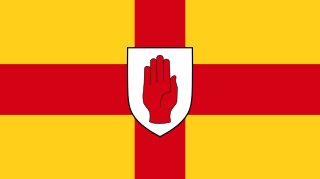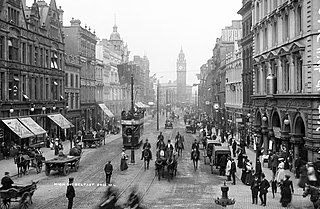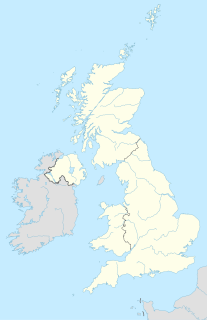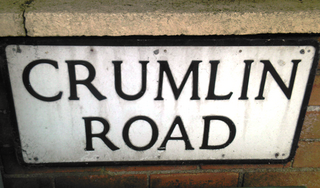
Belfast is the capital and largest city of Northern Ireland, standing on the banks of the River Lagan on the east coast. It is the 12th-largest city in the United Kingdom and the second-largest on the island of Ireland. It had a population of 343,542 as of 2019. Belfast suffered greatly during the violence that accompanied the partition of Ireland, and especially during the more recent conflict known as the Troubles.

Ulster is one of the four traditional Irish provinces, in the north of Ireland. It is made up of nine counties: six of these constitute Northern Ireland ; the remaining three are in the Republic of Ireland.

Linen is a textile made from the fibers of the flax plant.

Carrickfergus is a large town in County Antrim, Northern Ireland. It sits on the north shore of Belfast Lough, 11 miles (18 km) from Belfast. The town had a population of 27,998 at the 2011 Census. It is County Antrim's oldest town and one of the oldest towns in Ireland as a whole. Carrickfergus Castle, built in the late 12th century at the behest of Anglo-Norman knight John de Courcy, was the capital of the Earldom of Ulster. After the earldom's collapse, it remained one of the only English outposts in Ulster for the next four centuries. Carrickfergus was the administrative centre for Carrickfergus Borough Council, before this was amalgamated into the Mid and East Antrim District Council in 2015, and forms part of the Belfast Metropolitan Area. It is also a townland of 65 acres, a civil parish and a barony.

Lisburn is a city in Northern Ireland. It is 8 mi (13 km) southwest of Belfast city centre, on the River Lagan, which forms the boundary between County Antrim and County Down. First laid out in the 17th century by English and Welsh settlers, with the arrival of French Huguenot in the 18th the town developed as a global centre of the linen industry.

The history of the Jews in Ireland extends back nearly a thousand years. Although the Jewish community in Ireland has always been small in numbers, it is well established and has generally been well-accepted into Irish life. Jews in Ireland have historically enjoyed a relative tolerance that was largely absent elsewhere in Europe.

Benburb ) is a village and townland in County Tyrone, Northern Ireland. It lies 7.5 miles from Armagh and 8 miles from Dungannon. The River Blackwater runs alongside the village as does the Ulster Canal.
The Public Record Office of Northern Ireland (PRONI) is situated in Belfast, Northern Ireland. It is a division within the Engaged Communities Group of the Department for Communities (DfC).

The Linen Hall Library is located at 17 Donegall Square North, Belfast, Northern Ireland. It is the oldest library in Belfast and the last subscribing library in Northern Ireland. The Library is physically in the centre of Belfast, and more generally at the centre of the cultural and creative life of the wider community. It is an independent and charitable body.

The Belfast Blitz consisted of four German air raids on strategic targets in the city of Belfast in Northern Ireland, in April and May 1941 during World War II, causing high casualties. The first was on the night of 7–8 April 1941, a small attack which probably took place only to test Belfast's defences. The next took place on Easter Tuesday, 15 April 1941. 200 Luftwaffe bombers attacked military and manufacturing targets in the city of Belfast. Some 900 people died as a result of the bombing and 1,500 were injured. High explosive bombs predominated in this raid. Apart from those on London, this was the greatest loss of life in any night raid during the Blitz.

Belfast City Hall is the civic building of Belfast City Council located in Donegall Square, Belfast, Northern Ireland. It faces North and effectively divides the commercial and business areas of the city centre. It is a Grade A listed building.

The history of Belfast as a settlement begins during the Iron Age, while its status as a major urban centre originates to the 18th century. Belfast is the capital of Northern Ireland. Belfast was throughout its modern history a major commercial and industrial centre. In the late 20th century its traditional industries, particularly shipbuilding, declined. The city's history has been marked by violent conflict between Catholics and Protestants that caused many areas to split into Catholic and Protestant neighborhoods. In recent years, the city has been relatively peaceful and major redevelopment has occurred, especially in the inner city and dock areas.

Cregagh is an area southeast of Belfast in County Down, Northern Ireland. It is the name of a townland and has been adopted as the name of an electoral ward of Belfast City council. The townland dates back to medieval times, when it was part of the territory held by the O'Neills of Clannaboy. The area is centred on the Cregagh Road. The Woodstock/Cregagh Road is a continuous arterial route in the city, with the Woodstock making up the lower half of the route and the Cregagh the upper half. It runs from the Albertbridge Road, close to the Short Strand, to the A55 Outer Ring road.

Harford Montgomery Hyde, born in Belfast, Ireland, was a barrister, politician, prolific author and biographer. He was deselected by his party in 1959, losing his seat in the House of Commons, as a result of campaigning in favour of homosexual law reform.

The Cathedral Quarter in Belfast, Northern Ireland, is a developing area of the city, roughly situated between Royal Avenue near where the Belfast Central Library building is, and the Dunbar Link in the city centre. From one of its corners, the junction of Royal Avenue, Donegall Street and York Street, the Cathedral Quarter lies south and east. Part of the area, centred on Talbot Street behind the cathedral, was formerly called the Half Bap. The "Little Italy" area was on the opposite side of Great Patrick Street centred on Little Patrick Street and Nelson Street.
The economy of Belfast, Northern Ireland was initially built on trade through Belfast Harbour. Later, industry contributed to its growth, particularly shipbuilding and linen. At the beginning of the 20th century Belfast was both the largest producer of linen in the world and also boasted the world's largest shipyard. Civil unrest impacted the city's industry for many years, but with the republican and loyalist ceasefires of the mid-1990s, Good Friday Agreement and the St Andrews Agreement in 2006, the city's economy has seen some resurgence once again.

Banbridge is a town in County Down, Northern Ireland. It lies on the River Bann and the A1 road and is named after a bridge built over the River Bann in 1712. It is situated in the civil parish of Seapatrick and the historic barony of Iveagh Upper, Upper Half. The town began as a coaching stop on the road from Belfast to Dublin and thrived from Irish linen manufacturing. The town was home to the headquarters of the former Banbridge District Council. Following a reform of local government in Northern Ireland in 2015, Banbridge became part of Armagh City, Banbridge and Craigavon Borough Council. It had a population of 16,637 in the 2011 Census.

The Linen Quarter is a vibrant area of Belfast city centre. The name is derived from the great many linen warehouses that are still present in the area. The Linen Quarter is host to some of the major cultural venues of Belfast, including the Ulster Hall and Grand Opera House, alongside a large number of hotels, bars, restaurants and cafes. The district also includes the main transport hub of Belfast.

The Crumlin Road is a main road in north-west Belfast, Northern Ireland. The road runs from north of Belfast City Centre for about four miles to the outskirts of the city. It also forms part of the longer A52 road which leads out of Belfast to the town of Crumlin. The lower section of the road houses a number of historic buildings, including the city's former law courts and prison, whilst the road encompasses several large housing areas, including Ardoyne, Ballysillan and Ligoniel(from Irish: Lag an Aoil, meaning hollow of the lime)..

The Water Office is a former warehouse at 1 Donegall Square, Belfast, Northern Ireland, that is listed by the Northern Ireland Department for Communities at grade B1, citing both "Historic Interest" and "Architectural Interest".





















